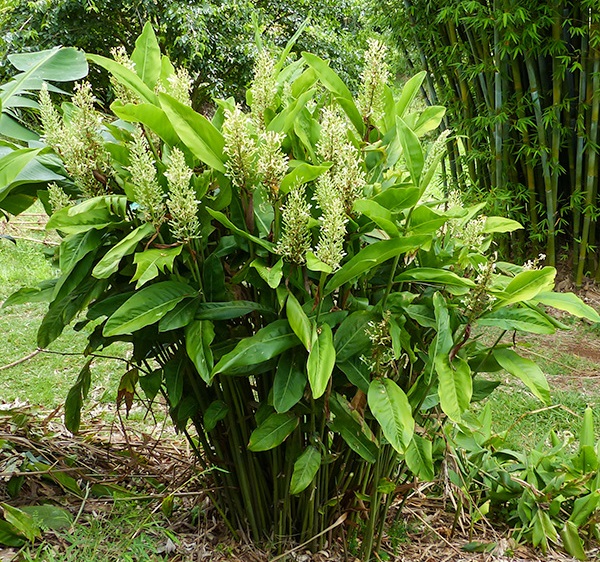Lesser Galangal – Alpinia officinarum

Common Names: Lesser Galangal, Galangal, Alpinia, China root, Chinese ginger, Colic Root, East India root, Gao Liang, Petit Galanga, Gargaut, Rasna, Red Ginger, Gingembre Rouge, Languas officinarum, Alpinia officinarum
Latin Name: Alpinia officinarum
Origin: Asia
Short Introduction
Alpinia officinarum, also known as Lesser Galangal, is cultivated in Southeast Asia and is originally native to China.
Detailed Description
A fascinating herb from the ginger family with a wide range of traditional and modern uses.
Botanical Information
Lesser Galangal is a perennial tropical herb that can reach up to 2 meters in height due to its tall stem. Its leaves are lanceolate, sessile, long, thin, and its white to greenish flowers, adorned with red streaks, appear in clusters at the stem tops. The plant produces a fleshy, red capsule containing hard, bitter seeds.
The creeping rhizome is highly branched, slim and tough, and is the main reason for the plant’s cultivation. The rhizome features an orange flesh, brown skin, aromatic scent, and sweet flavor.
Origin and Distribution
Lesser Galangal originates in China and continues to thrive mainly along the southeastern coastline, including Hainan. Over the centuries, its cultivation has spread to Japan, Thailand, Vietnam, and India. Today, Hong Kong is an important trading hub for galangal, facilitating its sale and distribution.
Usage / Dosage
The rhizome was widely used throughout ancient and medieval Europe as a flavoring and aromatic agent, particularly for sweet spices and rose-scented blends. While its popularity declined in Europe, it remains an essential ingredient in Asian cuisine, where ground rhizome is used in curries, beverages, and jellies. In India, galangal extract is blended into perfumes, and Tatar communities prepare tea from it.
Traditional Medicine
Traditional herbal medicine values Lesser Galangal for supporting digestion, relieving bloating, and easing gastric and intestinal spasms. Herbalists also employ galangal to improve circulation, especially in peripheral areas. It is thought to have a positive effect on the nervous system, possibly boosting blood flow to the brain, thus supporting memory and sensory functions.
Folk medicine recommends using galangal in blends for angina pectoris and, more recently, some cancer therapies. In Indian Ayurveda, it is used for fever, lung discomfort, excess mucus, weak heart, and as a digestive. Traditionally, it has been prescribed for poor appetite, indigestion, nausea, diarrhea, liver and gallbladder issues, cough, and bronchial inflammation. Swedish bitters—a well-known herbal tonic—contains galangal for digestive complaints. Externally, it is sometimes applied to alleviate rheumatism and arthritis due to its warming, stimulating qualities.
Anti-inflammatory and Antioxidant Properties
Bioactive compounds in Alpinia officinarum demonstrate notable anti-inflammatory activity, including anti-tumor potential against various cancer cell lines. Extracts of the dried rhizome have shown positive results for both in vivo anti-inflammatory and in vitro antioxidant activity. Specific compounds isolated from the plant exhibit anti-inflammatory effects comparable to standard drugs such as diclofenac. The methanolic rhizome extract contains antioxidants like p-coumaryl alcohol and unique phenols that enhance free radical scavenging.
Antiproliferative and Anticancer Effects
Studies have demonstrated the ability of Lesser Galangal extracts to inhibit cancer cell proliferation by triggering apoptosis—particularly in breast carcinoma and leukemia cell lines. Certain ethyl acetate fractions from the rhizome displayed cytotoxicity against human cancer cell lines, including human glioblastoma and hepatoma. Other compounds also demonstrated selectivity towards these and additional tumor types.
Antibacterial Effects
Alcoholic extracts of the rhizome exhibit considerable antibacterial properties against Bacillus cereus, Staphylococcus aureus, Pseudomonas aeruginosa, Escherichia coli, alpha- and beta-hemolytic streptococcus, and Streptococcus pneumoniae, outperforming cold-extracted preparations and sometimes showing better antioxidant effects than ascorbic acid.
Active Compounds
The herb’s rhizome is particularly rich in essential oils with high content of pinene, cineole, cadinene, and others. Additional constituents include flavonoids, starch, resins, and the flavonol galangin. The rhizome also contains alkaloids, proteins, carbohydrates, amino acids, natural sterols, and tannins. In the aerial parts, the antioxidant resveratrol is present. Chemical analysis has identified multiple flavonoids (such as chrysin, pinocembrin, tectochrysin, apigenin, and galangin) and diarylheptanoids, many contributing to its medicinal attributes.
Traditional Dosage
Dosage depends on form: For a 10:1 extract, the recommended daily dose is 0.3–0.6 g, mixed into water or other beverages, and it may also be added to foods such as smoothies, yogurts, or shakes. Dried powdered rhizome can be prepared as an infusion using 0.5–1 g in 150 ml of boiling water, steeped for 10 minutes, then strained. This infusion is traditionally taken three times daily, half an hour before meals on an empty stomach.
